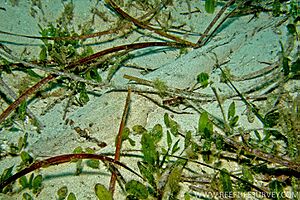Longhead flathead facts for kids
Quick facts for kids Longhead flathead |
|
|---|---|
 |
|
| A well-camouflaged Longhead flathead (Levipora inops) at Albany, Western Australia | |
| Conservation status | |
| Scientific classification | |
| Synonyms | |
|
The Longhead flathead (Leviprora inops) is a type of fish. It is also called the crocodile flathead or weed flathead. This fish belongs to a group called flatheads. You can only find this special fish in the coastal waters of southern Australia. It likes to live near reefs.
What It Looks Like
The Longhead flathead has a long, slightly flat body. Its head is very long, making up about two-fifths of its total body length. The head is quite flat and smooth. It has large eyes with a cool, fringed flap on the iris.
Its mouth is big with many small teeth. These teeth are on both its upper and lower jaws. It also has two patches of teeth on the roof of its mouth. There are two tiny spines near its cheek area.
This fish has two dorsal fins on its back. The first one is short with 8 or 9 spines. The very first spine is separate and tiny. The second dorsal fin is longer and has 12 soft rays. Its anal fin is under the second dorsal fin. It looks similar and has 11 to 13 soft rays.
Longhead flatheads can grow up to 61 centimetres long. They can weigh at least 2.5 kilograms. Their upper body is sandy or pinkish. It has spots and blotches that are not regular in shape. The lower part of its body is lighter. Its fins have faint lines of dark and light spots. The first dorsal fin has a brown band on its upper part.
Where It Lives
The Longhead flathead lives only in southwestern Australia. You can find it from Kangaroo Island and Gulf St Vincent in South Australia. It also lives west to the Swan River in Western Australia.
This fish prefers shallow coastal waters. It especially likes rocky reefs that are covered in thick plants. Young flatheads are often found buried in sand in seagrass beds. They can live in waters as deep as 20 metres.
What It Eats
The Longhead flathead mostly eats other fish. But it will also eat large crustaceans that live on the seafloor.


